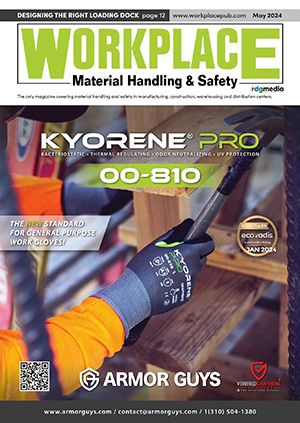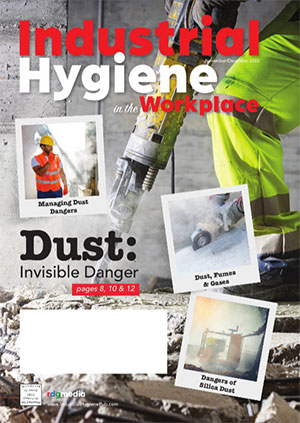Cranes, Hoists and Overhead Handling Equipment
 Overhead handling equipment, such as cranes and hoists, can increase productivity and make the best use of floor space, as well as enhance safety and improve ergonomics in a facility. Overhead materials handling equipment comes in many forms, but each has the same basic goal: to safely lift product and move it (efficiently and ergonomically) from point A to point B—without damage to the product or the facility—and without injury to employees.
Overhead handling equipment, such as cranes and hoists, can increase productivity and make the best use of floor space, as well as enhance safety and improve ergonomics in a facility. Overhead materials handling equipment comes in many forms, but each has the same basic goal: to safely lift product and move it (efficiently and ergonomically) from point A to point B—without damage to the product or the facility—and without injury to employees.
Back to Basics and Beyond
First, the basics: A hoist is a device used for lifting and lowering loads, while a crane is a device used for moving loads in different directions. A hoist is a relatively simple device; a crane is more complex. Hoists can only move loads vertically, but cranes can move loads both vertically and horizontally.
In construction, there are multiple types of cranes. These include mobile cranes, telescopic cranes, tower cranes, truck-mounted cranes (aka, boom or picker trucks), rough terrain cranes, loader cranes (aka folding boom) and overhead cranes.
Larger overhead cranes (i.e., goliath cranes) can be used in shipyards and large outdoor manufacturing plants. The hoist is set on a trolley, which will move in one direction along one or two beams, which move at angles to that direction along elevated or ground level tracks, often mounted along the side of an assembly area.
The overhead crane is also often referred to as a suspended crane; this type is normally used in a factory, with some of them being able to lift very heavy loads.
Overhead handling solutions can range from simple, manual hoists to fully automated systems with software-directed movement. The equipment should carry the bulk of the work. This is especially important for the equipment located in the middle of a warehouse space, where people are working.
The right equipment for the job depends on four main factors: the process, the product being moved, the task being performed and the desired rate of throughput. There are many choices in overhead handling equipment, mainly due to the different types of technology and configurations/uses of the equipment. An operation’s final choice should be based on what performance is needed.
Cranes 101
Cranes can be manual or power-driven, depending on application and size of the load. For example, workstation cranes and jib cranes are used to improve ergonomics in smaller areas; bridge and gantry cranes handle the heavy lifting tasks over longer distances.
Even though there are many types/styles of crane, they all include the components of a bridge, a trolley and a hoist. The bridge can be stationary or mobile and is made of rails. It can carry one or more trolleys. The trolley is a unit that travels side-to-side; it carries the hoist. The hoist is a lifting device that manipulates the load (and is hooked onto the load).
Cranes are available in various load capacities, from workstation cranes that enable operators in a work station to safely manipulate light loads, to large overhead cranes that can transport loads weighing as much as 500 tons. Cranes with lifting capacities above 50 tons are usually engineered solutions with controls specifically designed for the manufacturing process that the cranes support.
Smaller Cranes
Smaller, free-standing workstation cranes enable operators in a work station to maneuver light loads. These free-standing units improve ergonomic handling of product in a limited area, such as production environments.
Some of the newer workstation cranes are intelligent devices that combine manual and servo-driven operations. The manual function allows workers to move at their own pace, as they walk to a bin, select a part and guide the crane to a machining center process, for example. The servo-driven function controls the positioning of the part on the machine, preventing damage by slowing down for part placement and release.
A gantry crane is comprised of two uprights connected by an I-beam that serves as the bridge for the trolley. Gantry cranes can be manual or powered. In a powered gantry crane, the uprights run on a track at floor level. Lighter duty cranes consist of uprights on wheels; they can be manually positioned and repositioned around a facility. Gantry cranes are most commonly used in maintenance operations, as they have load capacities of up to 5 tons and spans of up to 30ft. For applications and uses that require infrequent duty, gantry cranes are often cost-effective.
Another crane often used for spot-handling is a jib crane. They include a single bridge that rotates to cover a circular area. Because it rotates, this type of crane makes it easy to position loads. Jib cranes are frequently used in conjunction with an overhead crane to improve throughput in areas with more traffic and production than a single crane can handle. Free-standing jib cranes are bolted to the floor and require a strong foundation, in order to support the load without tipping over. They also offer 360-degree rotation. Articulating-arm jib cranes are equipped with a two-piece, pivoting arm—giving an operator precise load-positioning control.
Overhead Cranes
An overhead crane, as stated above, enables product to be moved above the floor. This type of crane is often use when it is unproductive, impractical—or safe—to move materials either manually or by lift truck. Overhead cranes allow for coverage of a larger manufacturing plant area—instead of just being limited to aisle space, for example. This type of crane can move material through the manufacturing or storage process, using all of the free space overhead.
Overhead cranes have the most lifting capacity. Bridge and gantry cranes can do heavy lifting over long distances. Bridge cranes are ceiling-mounted and allow loads to move in six directions: up and down; backward and forward; and side to side. They are often part of a building’s structure and installed during the facility’s construction.
Bridge cranes are always powered and consist of a trolley that runs across a bridge, which can have one or two girders. The bridge moves across a bay along a runway. The largest capacity units—known as top-running, double-girder cranes—mount the bridge on top of the runway and have two girders for the bridge. With capacities of up to 600 tons, a top-running crane allows the maximum headroom of any crane. Alternately, under-hung cranes, which are ideal for loads of 15 tons or less, have a trolley that runs on the bottom of the support I-beams.
There also are under-hung cranes, where the trolley runs on the bottom of the support I-beams and can get loads closer to the wall. While distance is no impediment for this type of crane, an under-hung crane cannot lift a load as high as a top-running crane system. They are usually used for loads of less than 15 tons.
Hoists that Heave
Although hoists are essentially an “old industry,” many manufacturers have adapted the latest technology to make hoists safer (and more reliable). The hoist can be a key part of a crane system, but these mechanical devices can also stand alone for vertical lifting jobs, raising and lowering loads.
There are three categories of hoist, primarily based on their power source. These are manual (including hand-chain and ratchet-lever hoists); air-driven; and electric hoists (includes wire rope and chain hoists).
Manual Hoists
Small and mobile, the slower, manual hoists are customarily used for maintenance and other non-repetitive tasks. Manual lifting devices, like hand-chain and rachet-lever hoists, are affordable and very effective at their simple tasks.
Hand-chain hoists have two chains: one chain attached to the load and a pull chain. As an operator pulls the pull chain, the hoist’s internal gears raise and lower the lift chain and provide the mechanical advantage for easing the lifting process. Although these hoists can lift 70-ton loads, the majority of the market is in the less than 5-ton range.
Rachet-lever hoists can use either wire rope or chain. They work like hand chain hoists but use a lever, rather than a pull chain, to rotate the sprocket that activates the lifting mechanism. With capacity ranges from 500lbs to 9 tons, rachet-lever hoists are perfect for low-lift applications, often less than 5ft. Rachet-lever hoists can lift vertically and pull horizontally; they’re more commonly used for pulling, instead of lifting tasks.
Air-driven Hoists
Air driven (aka, pneumatic) hoists have no electric motors; they also do not require electricity and won’t overheat. They have the ability to facilitate highly repetitive, assembly line applications, because they can be used continuously and don’t need the cooling time that electric hoists require. These hoists are ideal for mass production, production lines and foundries.
The majority of air-driven hoists use chain as the lifting medium. They function much like electric chain hoists, but they are not hard-wired to an electrical system.
Electric Hoists
Electric hoists are the most common type of hoist. These hoists range in lift capacities from 250lbs, which can be purchased off-the-shelf, to several hundred tons, which are usually custom-engineered.
All electric hoists are rated by duty cycle. The rating determines how long the hoist’s electric motor can run before it needs to cool. This means that an electric hoist with a 25% duty cycle can be used continuously for 25% of an hour (or 15 minutes), before it needs to cool.
Electric hoists are made with single-speed, double-speed or variable-speed electric motors. Single-speed motors are the least expensive; double- and variable-speed motors offer a few more advantages. An operator of a double-speed hoist can begin lifting a load at a slow speed, then ease into a higher lifting speed. This reduces shock on the system and extends the life of the hoist. Operators can slow the hoist at the end of a lift, as well, thus allowing for more precise and gentler load positioning.
Electric hoists are hard-wired to a power source, so must have a dedicated location in a facility. Electric hoists are available in wire rope and chain designs. Improvements to the strength of wire rope or chain used as the lifting medium have made such designs more effective and longer lasting.
Wire rope hoists are used to lift very heavy loads and are controlled by an operator. The motor drives a set of gears, which then turns a grooved drum. The wire rope winds around the drum, as it turns and lifts the load. These hoists can reach capacities of hundreds of tons, but the majority are 5- and 10-ton models. They are frequently used for such jobs as automotive equipment assembly.
Chain hoists are also manually activated. An operator starts the electric motor that turns a set of gears, which then turns a lift wheel. Pockets in the lift wheel engage the links of the chain that raise the load as the chain rides over the wheel. The chain coming off the wheel either hangs or is collected in a container below the hoist. Chain hoists range in capacity from 250lbs-20 tons. Although more maneuverable and smaller than wire rope hoists, chain hoists are slower. WMHS



